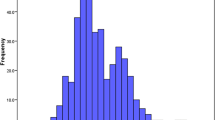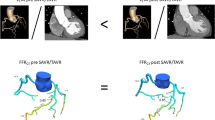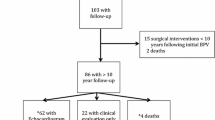Abstract
Objectives
To investigate follow-up after percutaneous pulmonary valve implantation (PPVI).
Methods
Forty patients with pulmonary conduit dysfunction (males/females 24/16; 21 ± 08 years; 12 tetralogy of Fallot, 11 aortic valve disease, 17 other congenital heart disease) were planned for CMR before PPVI and repeated 7 times up to 48 months. CMR prospective results regarded: pressure gradient (PG) and regurgitation fraction (RF); end-diastolic volume, end-systolic volume, and stroke volume indexed to body surface area (EDVI, ESVI, and SVI); ejection fraction (EF) of right and left ventricles (RV, LV). A Friedman test was used for comparisons.
Results
Overall, PG (31 ± 06 to 16 ± 4 mmHg), RF (16 ± 17 to 0.3 ± 1 %), RVEDVI (82 ± 38 to 58 ± 12 ml/m2), and RVESVI (44 ± 12 to 30 ± 13 ml/m2) declined (p < 0.001), RVEF (49 ± 13 to 58 ± 12 %) and RVSVI (from 38 ± 14 to 40 ± 8 ml/m2) increased (p < 0.001), LVEDVI (67 ± 17 to 73 ± 18 ml/m2) and LVSVI (37 ± 11 to 43 ± 10 ml/m2) increased (p = 0.034 and p < 0.001). Two patients had valve fracture at 24 and 36 months and underwent surgery. One patient had stent restenosis at 24 months and underwent percutaneous retreatment. Baseline/follow-up CMR did not predict PPVI failure.
Conclusions
CMR demonstrated restored pulmonary conduit function, reduced RV volumes and increased RV and LV function but did not predict valve fracture/restenosis.
Key points
• A CMR 4-year follow-up after PPVI showed restored pulmonary conduit function
• RV volumes were significantly reduced
• RV function was significantly better in terms of increased EF and SVI
• LV function was significantly better in terms of increased EDVI and SVI
• Baseline/follow-up CMR did not predict three cases of PPVI failure





Similar content being viewed by others
References
Khambadkone S, Bonhoeffer P (2004) Nonsurgical pulmonary valve replacement: why, when, and how? Catheter Cardiovasc Interv 62:401–408
Bonhoeffer P, Boudjemline Y, Saliba Z et al (2000) Percutaneous replacement of pulmonary valve in a right-ventricle to pulmonary-artery prosthetic conduit with valve dysfunction. Lancet 356:1403–1405
Stark J (1998) The use of valved conduits in pediatric cardiac surgery. Pediatr Cardiol 19:282–288
Lurz P, Bonhoeffer P, Taylor AM (2009) Percutaneous pulmonary valve implantation: an update. Expert Rev Cardiovasc Ther 7:823–833
Eyskens B, Reybrouck T, Bogaert J et al (2000) Homograft insertion for pulmonary regurgitation after repair of tetralogy of fallot improves cardiorespiratory exercise performance. Am J Cardiol 85:221–225
Kanter KR, Budde JM, Parks WJ et al (2002) One hundred pulmonary valve replacements in children after relief of right ventricular outflow tract obstruction. Ann Thorac Surg 73:1801–1806
Gatzoulis MA, Elliott JT, Guru V et al (2000) Right and left ventricular systolic function late after repair of tetralogy of Fallot. Am J Cardiol 86:1352–1357
Conte S, Jashari R, Eyskens B et al (1999) Homograft valve insertion for pulmonary regurgitation late after valveless repair of right ventricular outflow tract obstruction. Eur J Cardiothorac Surg 15:143–149
Therrien J, Siu SC, Harris L et al (2001) Impact of pulmonary valve replacement on arrhythmia propensity late after repair of tetralogy of Fallot. Circulation 103:2489–2494
Li W, Davlouros PA, Kilner PJ et al (2004) Doppler-echocardiographic assessment of pulmonary regurgitation in adults with repaired tetralogy of Fallot: comparison with cardiovascular magnetic resonance imaging. Am Heart J 147:165–172
Valente AM, Cook S, Festa P et al (2014) Multimodality imaging guidelines for patients with repaired tetralogy of fallot: a report from the american society of echocardiography: developed in collaboration with the society for cardiovascular magnetic resonance and the society for pediatric radiology. J Am Soc Echocardiogr 27:111–141
McElhinney DB, Hellenbrand WE, Zahn EM et al (2010) Short- and medium-term outcomes after transcatheter pulmonary valve placement in the expanded multicenter US melody valve trial. Circulation 122:507–516
Eicken A, Ewert P, Hager A et al (2011) Percutaneous pulmonary valve implantation: two-centre experience with more than 100 patients. Eur Heart J 32:1260–1265
Lurz P, Nordmeyer J, Giardini A et al (2011) Early versus late functional outcome after successful percutaneous pulmonary valve implantation: are the acute effects of altered right ventricular loading all we can expect? J Am Coll Cardiol 57:724–731
Hendel RC, Patel MR, Kramer CM et al (2006) ACCF/ACR/SCCT/SCMR/ASNC/NASCI/SCAI/SIR 2006 appropriateness criteria for cardiac computed tomography and cardiac magnetic resonance imaging: a report of the American College of Cardiology Foundation Quality Strategic Directions Committee Appropriateness Criteria Working Group, American College of Radiology, Society of Cardiovascular Computed Tomography, Society for Cardiovascular Magnetic Resonance, American Society of Nuclear Cardiology, North American Society for Cardiac Imaging, Society for Cardiovascular Angiography and Interventions, and Society of Interventional Radiology. J Am Coll Cardiol 48:1475–1497
Secchi F, Resta EC, Piazza L et al (2014) Cardiac magnetic resonance before and after percutaneous pulmonary valve implantation. Radiol Med 119:400–407
Secchi F, Di Leo G, Papini GD et al (2011) Cardiac magnetic resonance: impact on diagnosis and management of patients with congenital cardiovascular disease. Clin Radiol 66:720–725
Vogt FM, Theysohn JM, Michna D et al (2013) Contrast-enhanced time-resolved 4D MRA of congenital heart and vessel anomalies: image quality and diagnostic value compared with 3D MRA. Eur Radiol 23:2392–2404
Van Dijck I, Budts W, Cools B et al (2014) Infective endocarditis of a transcatheter pulmonary valve in comparison with surgical implants. Heart 0:1–6
Kramer CM, Barkhausen J, Flamm SD, Kim RJ, Nagel E (2013) Society for Cardiovascular Magnetic Resonance Board of Trustees Task Force on Standardized Protocols. Standardized cardiovascular magnetic resonance (CMR) protocols 2013 update. J Cardiovasc Magn Reson 15:91
Caudron J, Fares J, Lefebvre V, Vivier PH, Petitjean C, Dacher JN (2012) Cardiac MRI, assessment of right ventricular function in acquired heart disease: factors of variability. Acad Radiol 19(8):991–1002
Kilner PJ, Gatehouse PD, Firmin DN (2007) Flow measurement by magnetic resonance: a unique asset worth optimising. J Cardiovasc Magn Reson 9:723–728
Secchi F, Iozzelli A, Papini GD et al (2009) MR imaging of aortic coarctation. Radiol Med 114:524–537
Butera G, Milanesi O, Spadoni I et al (2013) Melody transcatheter pulmonary valve implantation. Results from the registry of the Italian Society of Pediatric Cardiology. Catheter Cardiovasc Interv 81:310–316
Acknowledgments
The scientific guarantor of this publication is Professor Francesco Sardanelli. M Carminati is consultant/proctor for Medtronic and Edwards; F. Sardanelli has received research grants from and is a member of the speakers’ bureau for Bracco Imaging. The remaining authors of this manuscript declare no relationships with any companies whose products or services may be related to the subject matter of the article. The authors state that this work has not received any funding. One of the authors has significant statistical expertise. Institutional Review Board approval was obtained. Methodology: retrospective, observational, performed at one institution.
Author information
Authors and Affiliations
Corresponding author
Rights and permissions
About this article
Cite this article
Secchi, F., Resta, E.C., Cannaò, P.M. et al. Four-year cardiac magnetic resonance (CMR) follow-up of patients treated with percutaneous pulmonary valve stent implantation. Eur Radiol 25, 3606–3613 (2015). https://doi.org/10.1007/s00330-015-3781-5
Received:
Revised:
Accepted:
Published:
Issue Date:
DOI: https://doi.org/10.1007/s00330-015-3781-5




